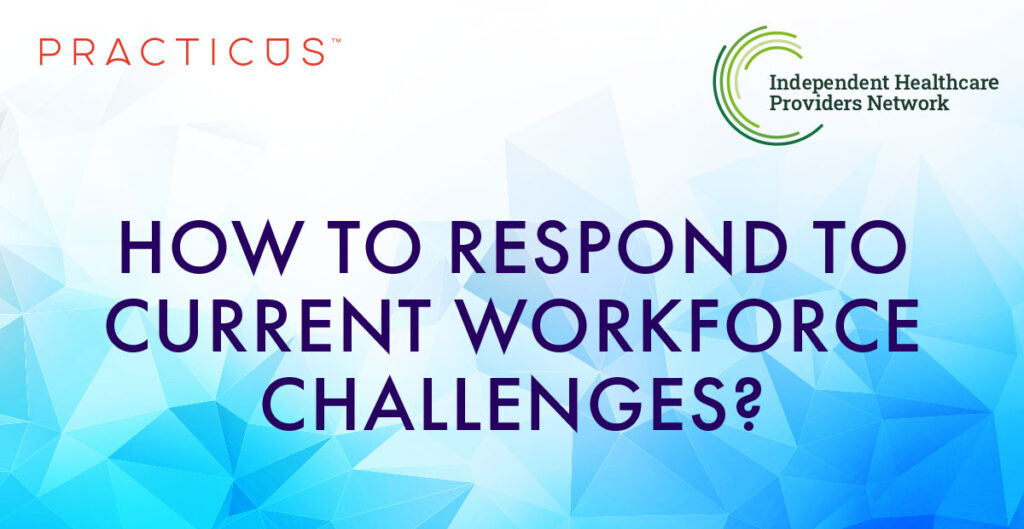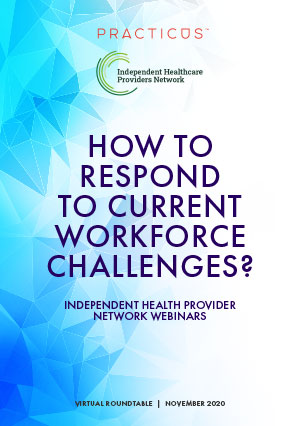How to respond to current workforce challenges?

Andrew Vaux – Head of Independent Healthcare , Practicus
2020 is the first year that IHPN has run its industry barometer survey to take the temperature of the independent healthcare sector and the challenges and opportunities facing its leaders. In the context of COVID-19 and, of course, it makes sense to bring leaders together for a deeper dive into those topics through a series of webinars. As sponsor of the Industry Barometer, it was something that Practicus was keen to facilitate and see what advice and solutions could be generated in discussion.

Download the full report of the
Roundtable Discussion

Transforming Co-existence into collaboration for the Long Haul
One of the major issues that came out of the survey were the challenges surrounding the workforce. Perhaps no surprise to industry veterans, this has been a long-term challenge – albeit one exacerbated by the impacts of Brexit and the pandemic. It’s also an area that is seeing creative solutions being applied and new thinking adopted.
It’s a whole industry problem and joining us to discuss the topic were executives from right across the sector – including Nuffield Health, The Cleveland Clinic London, Alliance Medical and Circle to name a few – as well as a representative from NHS Employers.
At Practicus our purpose is to ‘help people navigate change’ and the early twenties already present much for us to navigate together. I hope the insights shared below prove useful to you.
N.B. The webinar took place under Chatham House Rules so all names and employers have been anonymised in order to create an environment where everyone felt safe to contribute effectively. In some instances, we provide necessary context to clarify the point being made. All comments are as made with the exception of improvements for grammar and brevity.
Section 1:
Workforce demand outstripping supply
The situation was nicely summed up from an NHS perspective. In the independent sector, it is often tempting to believe that the scale of the NHS provides a natural advantage around workforce issues but the grass is not necessarily any greener and confirms a truly sector-wide set of challenges:
“What I can share, is that many of the issues that our colleagues are experiencing in the independent sector around workforce supply are very similar to what we have been seeing in the NHS for a number of years. The supply of clinical professionals is something that exists only within our combined sector. I think some of the things that we were looking at pre COVID have just come more into the foreground through the recent pandemic. We need more people. And we need people to be doing things differently. And we need that transformation improvement agenda so that they are able to do it better. It’s about how do we invest in the people that we’ve got, not just to retain, but to develop them into perhaps different and changing roles? Then we’ve got people from outside the sector or entering the labour market for the first time. How do we attract them into the health and social care sector? And then we’ve got the overseas routes, which to be honest, in January [2020], we all thought was a very real route to filling a lot of our gaps in resource-challenged parts of the UK but is now less of an option. How do we adjust for that?”
A number of those attending built on these foundations, adding the link between new business strategy and prioritisation in the independent sector, i.e. the resource you need is determined by the work you are aiming to win:
• “The actual delivery part of the organisation will know their own data and know where their priorities are. But there are so many different solutions created from within the NHS, from the centre, how do you filter that as a commercial organisation. What’s the thing that’s right for us so that we can focus on the resource that’s need to deliver that piece?”
• “There’s also a sense that we are in some way robbing Peter to pay Paul between different aspects of healthcare delivery rather than solving the underlying problems. For example, we have a shortage in the UK health system of people who are qualified to do endoscopy, because the use of endoscopy has grown way beyond anything that anybody was planning for. We need to think, what’s the right level of flexibility to build into the skills we help people develop? We tend to look at sticking plaster solutions to a more fundamental problem. I think we’ve never wanted to admit, either at a government level or as an industry, what the cost would be of actually training domestically an adequate supply of workers for the UK health system, and that that kind of shows up in these kind of sticking plaster solutions.”
Doing things differently
Some references were made to the German model of care, which is more efficient in terms of nursing numbers because patients themselves and their family members take care of some of the workload that falls to qualified RNs in the UK:
• “I think about the German model, having come from Shin clinic, I know how they resource within the provision business – where they could have, at night, two nurses to a ward of 30 patients because patients and their family members are taking care of a lot of it. These things that we expect our qualified RNs to do actually isn’t getting them at their best and it also doesn’t acknowledge the qualifications that they have and where they add real value. So I was thinking that German model is quite an interesting one to look at.”
Attracting more into the sector
Attracting more resource into the sector helps lessen the issues for everyone and was a key point of discussion. One areas of focus was universities:
“I think there’s work that we can be doing in places with the universities. We should not ignore or give up on the issue of bursaries either. My partner’s daughter is in the final year of her nursing qualification and will be out on the market as an RN next summer. Every placement she goes to she gets offered a job because literally they are desperate to fill roles. I think if we can amplify the profession, and I think about nursing in particular but also elements of life health, so they are seen as more attractive professions to go into whether you’re a pharmacist or a radiographer or a physio… I think if we’re elevating the profession, reigniting the work to turn around the decision around bursaries, making old-fashioned professions attractive again and having them operate at the top of their license chair then we can make a big difference. Combine that with looking at the model that is successful in other systems, such as the German model, we could actually create a little bit of movement here.”
Another area of focus was apprenticeships. Indeed, one of the questions in the Barometer survey was around apprenticeships, and what came across was how valuable providers feel they are. Many felt that there are some challenges with this scheme:
• “It’s definitely something that needs to be on the agenda, but more for clinical rather than non-clinical, especially pitching towards theatres or ODPs and so forth.”
• “We’ve been looking into it, yet I don’t think there is quite the smooth process that smooth that would have organisations really lean into it and realise the vision behind apprenticeships.”
• “[In the NHS] we’ve got a lot of employers, so around 20,000 apprenticeship may sound like a lot but as a proportion of the workforce it’s really tiny. And some part of the NHS will take more apprenticeships than others, the ambulance sector are brilliant for example at funding their levy. But what’s interesting is that they’re also really into accepting the levy from others where they can to gift it across. Through some of the relationships they’ve got in place, they’ve really benefited from other NHS organisations not using the levy and gifting it across to them. And so we’ve got specific roles, I think, and functions where the levy works better to support apprenticeships. But we’ve really struggled to get the nurse degree apprenticeship off the ground. So as an employer, you’d have to pay 40% of actual costs, for instance, to have somebody doing the nurse degree apprenticeship and paying for somebody else to be on the ward when they’re off the job doing training. If you do that, for hundreds of people, it becomes a very expensive model very quickly. It’s not been affordable for employers to do it at scale. We, as an organisation, alongside others, have been lobbying quite heavy for that levy process to change, particularly for the occupations where you’ve got a large proportion of off the job training and the nursing degree apprenticeship is one of them.
• “What our DHSC Health Education England relationship has done is provide some funding this year to try and move the nurse degree apprenticeship at scale. We’ve had about 5,000 requests and offers from employers to really up the numbers so we are increasing from about thousand people through the nurse degree apprenticeship route to around training six and a half thousand over the next couple of years. This is a significant proportion of the number of people that we normally train. Through nursing, around 20,000 or so would go through a cohort per year. But that’s only because we’ve got central investment to make that happen.”
Environment
One of those attending has a new site in London and she underlined that environment and equipment is not just about patient care, it’s also makes a big difference to attracting staff:
• “I always think the best way to bring people in is the environment. Equipment is something too and we are blessed in terms of both at our organisation. We are fortunate we are giving people the opportunity to grow on the job, we’ve gone to a completely new environment, a completely new model of health care for that environment. Certainly, that is a big plus for us. Without worrying anybody on the call, we have seen such increased interest and it just continues to grow. I hope that it is something that is going to freshen the market and have a positive knock on effect for everybody. Around 75% of the interest has been from within London but we’ve had people come from much further afield to see what we’re doing, including flying in from Ireland or taking the train all the way from Scotland for open days.”
Section 2:
Retaining staff
It’s not just about attracting staff of course, there are many workforce issues around retention – and especially so at a time that has seen significant physical and mental fatigue due to the pandemic. But we began with a wider lens around long-term issues such as career development…
Career development
• “Some of our organisations have a national footprint where you can kind of shape your career within a single independent organisation. Whereas the NHS may be a national institution but it’s made up of thousands or organisations and sometimes there really isn’t opportunity advance without leaving your employer, you can’t just move to a different site or do your boss’s job somewhere else in the organisation. So it’s not as easy as some might think to build a kind of strategy career path within it. That kind of talent management is something that the independent sector can really have edge with and it can also help to alleviate regional pressures.
• “There is this theme with line managers, you have to kind of keep on knocking on their door saying, ‘Let people go. Let people grow and develop, don’t take the easy option to keep them with you. Because ultimately you will lose and ultimately you’re preventing them from being able to really fly.’”
• “It also helps with the life choices of employees where that may lead to them leaving. For example, someone who is a newly qualified nurse, a couple of years in, may want a heart of London experience and later, if they then want to start a family, then home health care industry may be of more interest to them. If we can tailor career paths that meet evolving care needs but also see employees as individuals who have their own evolving needs then we can better retain staff.”
Flexible working does not necessarily mean home working
• “We are doing some market research and, surprisingly this year, all the data we’re getting around what’s important to people is flexible working. And that shouldn’t necessarily mean working from home but flexible working in shifts and other matters. I think that we’re going to have to think really, really creatively about how we allow people to do their jobs because if we remain too rigid, people will leave the profession. Rumblings around work-life balance used to be quiet a few years ago but now it’s very loud.”
Playing to the strengths of the Independent Sector
• “One thing that we still hear is that actually a lot of people move into the independent sector from the NHS because they feel they do have the opportunity to do the job that they actually wanted to do when they went and trained to do it. There’s a feeling that they’ve lost that in an NHS context where people can feel like the pressure is so unrelenting that they simply actually want to get back to a kind of almost pure way of clinical practice and actually rediscovering some of that enjoyment and love that they have for what they do.”
• “We almost need to work out how do we tell the story about all the good things you find in the independent sector without seeming to try and criticise the NHS? Perhaps one part of that is some of the really excellent stuff we’ve seen happening recently with trainee surgeons coming to do some of their training in the independent sector.”
Mental Health of the workforce and burnout
• “I think the other big error that is worth highlighting is mental health. We have got to upskill our managers. We know, the whole issue around burnout in both sectors.”
• “I think of the experiences that people have had over the last six months with the pandemic, and the well-being conversation, and the confidence of managers to feel like they can say and do the right things that support people. We need to make sure people feel valued and that they are making a difference.”
Purpose
Having a sense of purpose was considered important by all:
• “A lot of the feedback that our carers and health care team gave us recently is that the jobs that felt like they were giving something – that had purpose – where they felt valued for what they did, that was really important to them. If it’s a dreadful situation then ‘purpose’ goes further up the priority list than say ‘pay’. And being able to offer something within those roles, which provides a connection to something bigger than themselves was a lot of what people were describing they prized in a job.”
• “I think having something where individuals can see that their employer is participating in the sector, and the sector’s issues, is important. And in way that leads into opportunities where people can engage in research and can engage in academics and lecturing, and so on.”
• “I’d say the single biggest factor in enabling us to get and retain good people is purpose and being really clear about what it is we’re trying to do and why we’re trying to do it. It is probably the most potent factor in staff retention and staff attraction.”
